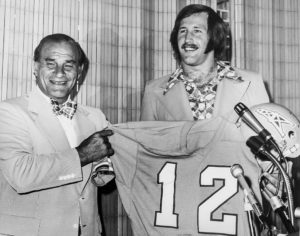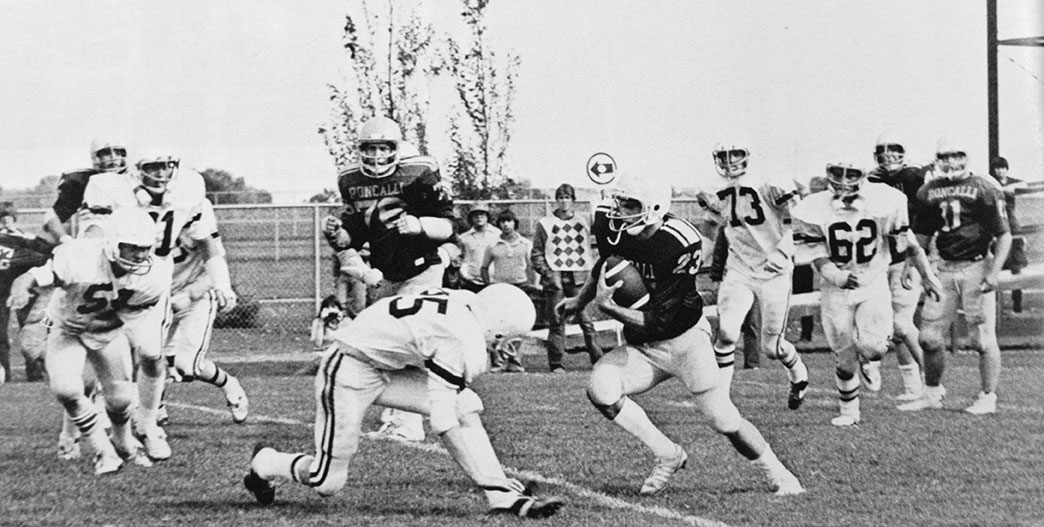

If You Can Make It Here, You Can Make It
Every fall, 100 or so Aberdeen athletes take the field to play football. Some of them no doubt have dreams of playing on bigger stages, and there are role models they can follow. In the past 50 years, some 20,000 students have graduated from Aberdeen high schools. A handful have gone on to play football at the highest levels of the game, and they’ve done all right for small town boys.
George Amundson
All these athletes were high school standouts, but George Amundson (CHS ’69) got national attention in 1969—10 years before ESPN. At the state track meet in Rapid City, the Central senior threw a discus farther than any American high schooler ever had, 211 feet, 4 inches, which is still a state record.
George was a football star too, but the first memory he shared was of off-field antics. After out-of-town games, he remembers, “We’d get back to Aberdeen, buy a dozen eggs and throw them at our friends’ cars while they were making out with their girlfriends!” His football throwing—and running—drew attention too, and after some college visits, he signed with Iowa State and head coach Johnny Majors, the former University of Tennessee star.
A quarterback in high school, George first played running back in college due to injuries on the team. As a junior, he set a team record, rushing for 1,316 yards and 15 touchdowns, and led the Cyclones to their first-ever bowl game, the 1971 Sun Bowl. As a senior, he returned to quarterback—“My love, because I like to be in charge”—and became the first player in school history to top 2,000 yards in total offense. Against Missouri, which Iowa State hadn’t beaten in years, George led the team to a big victory. Late in the game, Coach Majors wanted George to take a knee. Instead, “I called a quarterback sneak,” George laughs. “I yelled at Coach that taking a knee would hurt my average!” George was named the 1972 Big Eight Conference player of the year, beating out Nebraska’s Johnny Rodgers, who won the Heisman Trophy that year. George finished seventh in the Heisman voting.
In the NFL draft, the Houston Oilers selected George in the first round—still Iowa State’s only first round pick. In the first game of his second season, he scored three touchdowns, and “I led the league in scoring for a couple weeks!” Unfortunately, coaching changes pushed him to Philadelphia and then to St. Louis where injuries forced him to retire. Back in Houston, he joined Gulf Atlantic Packaging, where he’s worked ever since.
He remembers the influence of his high school football coach Don Reshetar and track coach Ron Stocking, who later coached at Iowa State. Johnny Majors—“who gave me the latitude to call my own plays”—is his favorite coach of all time, a feeling he must share with his college football buddies. When they got together with the old coach, “It was like Majors was holding court!”
Kent Clausen
As a Cavalier, Kent Clausen (RHS ’76) starred in three sports. He still holds several basketball records and earned a state discus championship. Football was his favorite, however. Recruited to the University of Montana as a quarterback, a change in offensive strategy moved him across the line, where he starred as a linebacker, compiling multiple 100-tackle seasons. He earned All-Big Sky Conference Team honors twice, All-Academic team three times, and team MVP.
Kent signed with the New York Jets in 1981. He told the American News that in training camp, free agents like him were put on the top floors, above the draft picks who were above the veterans. As camp went on, the upper floors emptied out when players were cut. “I was the only guy on the 13th floor and there was nobody on the 12th and very few on the 11th,” he remembers. He made the team, but injuries shortened his career. He’s spent the past few decades as a hotel developer in Washington State.
Ian de Hueck
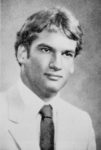
The scout team’s job was to run the next opponent’s offensive plays against the ND defense. “I thoroughly enjoyed it and looked forward to every practice,” he says. “It was a dream come true.” But if the scout team had a good play, he remembers, the coaches only saw it as a defensive breakdown. “So they’d stop practice and chew out the defense. Then we ran the same play again—against a defense that just got chewed out and knew what was coming,” he laughs. In his senior year, Ian played in two games. After his playing days, the philosophy major got an MBA from Northwestern in Evanston, Illinois, where he started a consulting firm 20 years ago.
Ian credits several Aberdonians for his successes. Former Roncalli athletic director Tom Murphy “let me do things in athletics as a pretty young kid, which was a great opportunity. Coach Jim Stephenson convinced the head coach to let me try a 44-yard field goal in a game,” which remains the longest successful attempt in Roncalli history.
Robb White
While he earned state accolades in basketball—third team All-State—and track—second in state at long jump—Robb White (CHS ’83) loved football. SDSU recruited him for its offensive line, but he wanted defense. Unbeknownst to Robb, “My track coach John Huth knew someone at USD and suggested they look at me.” They did, and he went there to play linebacker. Later he moved to defensive line where he excelled, earning first-team All-Conference twice and team captain as a senior. “I never had aspirations for the NFL,” he says, but after he played in the 1986 national championship game, “some teams showed interest in me.”
He was undrafted, but both the Washington Redskins and the New York Giants looked at him, and he chose the reigning Super Bowl Champion Redskins in 1988. The team kept him on injured reserve to save him for the future, until injuries necessitated that he start a game. Because he had been on reserve, however, league rules required the team either to exercise a special option to restore him to the roster or temporarily waive him. “So they waived me, figuring they’d sign me a day later,” he says. On the Friday before the game, an upset head coach Joe Gibbs “told me I could use the phone in his office to call Coach Parcells because I’d been picked up by the Giants on waivers.” Three days later, he was in New York practicing with the rival Giants. Later on for the Tampa Bay Buccaneers, he remembers, “I sacked Joe Montana.” He retired after stints in the World League of American Football and the Canadian Football League and now works near Kansas City in senior management for the manufacturing company to which he sold his two engineering firms.
In addition to Coach Huth, many people supported his career, and he singles out Redskins veteran defensive end All-Pro Charles Mann, “who helped this rookie get through camp and the season and invited me to his Bible study group.” He also indirectly credits one coach for helping instill a kind of confidence: “Maybe workday pressures are easier to bear after you’ve had Bill Parcells standing over you threatening to cut you from the team every day!”
Josh Heupel
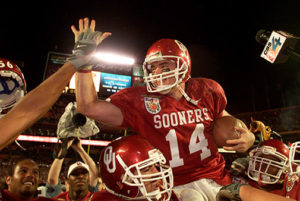
Josh Heupel led the Sooners to an undefeated season and a national championship with a victory over Florida State in the 2001 Orange Bowl.
Josh Heupel (CHS ’96) grabbed the golden ring in college, but maybe he was born for it. The son of Northern football coach Ken Heupel, whose team and staff meetings Josh attended as an elementary student, and CHS principal Cindy Heupel, whom Josh credits for his leadership skills, he was perhaps destined for gridiron greatness. After a stellar high school quarterback career, Josh embarked on what became a remarkable college career.
He accepted a scholarship from Weber State in Utah. After a good year on the field, an injury and offensive philosophy change led him to move to Snow College in Utah, where he passed for over 2,300 yards and 28 touchdowns in one season. Then he met Mike Leach, the incoming offensive coordinator at Oklahoma University, and the rest is history. Coming to a team with a storied history that had been down on its luck, Josh helped turn OU around. In a terrific undefeated 2000 season, he passed for 3,606 yards and led the NCAA by completing 64.6% of his passes. He earned, among other accolades, All-American and AP Player of the Year honors, plus he was the runner-up in the Heisman Trophy voting. Oklahoma won the national championship in the Orange Bowl, defeating Florida State and Heisman winner Chris Wenke.
Injuries curtailed his pro career, and Josh moved into coaching. “I absolutely knew I would be a coach one day,” he says, “I love the competitive side of the game and love mentoring kids to help them grow into who they’ll be.” By 2006, he was back at Oklahoma as the quarterback coach, where he coached two Heisman Trophy winners. In 2018, he became the head coach for the University of Central Florida, coaching the Knights to a 12-0 regular season record in his first year.
“The game has taken me so many different places,” Josh reflects. “I’ve had great opportunities to play and coach in great games, but it’s really about the relationships.” He adds, “Football does that. It bridges the gaps, the differences you’d see in the outside world.” Josh is also sometimes able to watch the next generation of Heupels play football. His third-grade son plays, but Josh is better at getting to the spring games, because he’s kind of busy in the fall.
Taylor Mehlhaff
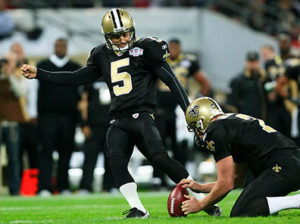
Taylor Mehlhaff kicks a goal during an NFL game between the San Diego Chargers and the New Orleans Saints in 2008.
As a quarterback and kicker, Taylor Mehlhaff (CHS ’04) led Central to the AA championship game and was named the state’s Gatorade High School Player of the Year. He also appeared at or near the top of numerous national rankings of high school kickers. A Nebraska fan, he ended up at Wisconsin where he had a stellar career, earning All-Big Ten (twice) and All-American honors. He is also third on the all-time Wisconsin scoring list—impressive, considering the guys ahead of him are the NCAA all-time touchdown leader Montee Ball and Heisman Trophy winner Ron Dayne.
“I had a pretty good college career to get the opportunity to go to the next level,” Taylor says. He had stints with the New Orleans Saints and Minnesota Vikings, but “Pro football didn’t turn out the way I’d hoped. I learned to have a completely different mindset.” He met his wife in New Orleans, however, and says, “I figured God had a plan.”
The University of Tennessee asked him to run their kicking camp and then offered him a special teams coaching job. “I jumped into it,” he says. “I missed the competitive sense of game day.” Eventually, he returned to Wisconsin, where he is a special teams assistant. Reflecting on his career, he says, “It feels like I haven’t worked a day in my life. I get to make a living kicking a football and now coaching it.”
He credits several Aberdeen coaches for influencing him. His eighth-grade coach Rick Kline told him if he worked hard over the summer he could kick for the varsity as a freshman. “He got me excited to perfect my kicking.” Taylor always looked up to head coach Mike Flakus. “I never wanted to let him down. He taught me how to work and go after something.”
•••
You can make it big out of Aberdeen, but South Dakota athletes have a hill to climb. As a college coach now, Taylor realizes how difficult it is to visit players in South Dakota. “Flying into Sioux Falls and driving to a town to see an athlete can take as much time as it takes to fly to Atlanta and visit six high schools with two to three prospects each,” he laments. But, obviously, some guys have made it work.
Aberdeen is a great place to play too, as Ian de Hueck recalls, “The Aberdeen community was a wonderful place to grow up. It was extremely supportive of young people in general. They’re some of the nicest people I’ve ever met, great role models. A lot of people and institutions contributed to my good fortune.” Hundreds of young athletes today can say the same thing. // –Patrick Gallagher












